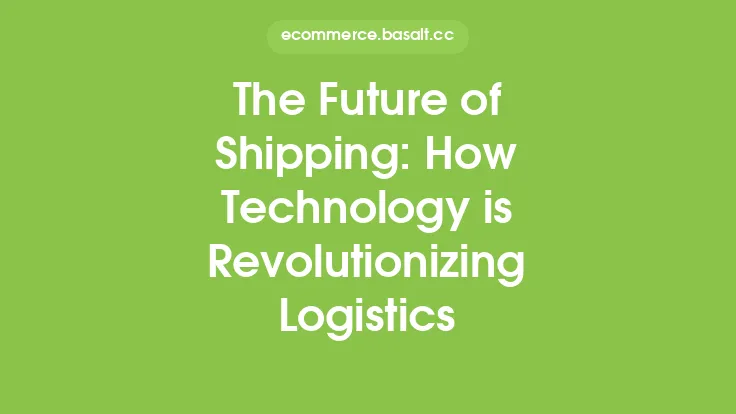The shipping industry is one of the largest contributors to greenhouse gas emissions, with estimates suggesting that it accounts for around 2.2% of global emissions. As concern about climate change continues to grow, the industry is under increasing pressure to reduce its carbon footprint. One way to achieve this is through the use of technology, which can help to improve efficiency, reduce waste, and promote sustainable practices. In this article, we will explore the role of technology in reducing the carbon footprint of the shipping industry.
Introduction to Sustainable Shipping
Sustainable shipping refers to the practice of transporting goods in a way that minimizes harm to the environment. This can involve using cleaner fuels, optimizing routes and schedules, and reducing waste. Technology plays a key role in sustainable shipping, as it can help to improve efficiency, reduce emissions, and promote sustainable practices. Some of the key technologies used in sustainable shipping include route optimization software, fuel-efficient propulsion systems, and data analytics platforms.
The Role of Technology in Reducing Emissions
Technology can help to reduce emissions in the shipping industry in a number of ways. For example, route optimization software can help to reduce fuel consumption by identifying the most efficient routes and schedules. This can help to lower emissions, as well as reduce costs and improve delivery times. Additionally, technologies such as wind-assisted propulsion and solar-powered ships can help to reduce reliance on fossil fuels and lower emissions.
Fuel-Efficient Technologies
One of the key ways to reduce emissions in the shipping industry is to use fuel-efficient technologies. These can include things like optimized hull designs, which can help to reduce drag and improve fuel efficiency. Additionally, technologies such as diesel-electric propulsion and gas-powered engines can help to reduce emissions and improve fuel efficiency. These technologies can be used in conjunction with other sustainable practices, such as slow steaming and weather routing, to help reduce emissions and improve efficiency.
Data Analytics and Sustainability
Data analytics plays a key role in sustainable shipping, as it can help to identify areas for improvement and optimize operations. By analyzing data on things like fuel consumption, emissions, and route efficiency, shipping companies can identify areas where they can improve and make changes to reduce their environmental impact. Additionally, data analytics can help to improve supply chain visibility, which can help to reduce waste and improve efficiency.
Digitalization and the Internet of Things (IoT)
Digitalization and the Internet of Things (IoT) are also playing a key role in sustainable shipping. The use of IoT devices and sensors can help to monitor and optimize ship operations, reducing waste and improving efficiency. Additionally, digitalization can help to improve supply chain visibility and reduce paperwork, making it easier to track and manage shipments. This can help to reduce emissions and improve delivery times, as well as reduce costs and improve customer satisfaction.
Alternative Fuels and Energy Sources
Alternative fuels and energy sources are also being explored as a way to reduce emissions in the shipping industry. These can include things like liquefied natural gas (LNG), hydrogen fuel cells, and biofuels. Additionally, technologies such as wind and solar power can be used to generate electricity and reduce reliance on fossil fuels. These alternative fuels and energy sources can help to reduce emissions and improve sustainability, as well as reduce costs and improve efficiency.
Regulatory Frameworks and Industry Initiatives
Regulatory frameworks and industry initiatives are also playing a key role in promoting sustainable shipping. The International Maritime Organization (IMO) has implemented a number of regulations aimed at reducing emissions, including the Sulphur Cap and the Energy Efficiency Design Index (EEDI). Additionally, industry initiatives such as the Sustainable Shipping Initiative and the Clean Shipping Index are working to promote sustainable practices and reduce emissions. These regulatory frameworks and industry initiatives can help to drive change and promote sustainability in the shipping industry.
Challenges and Opportunities
Despite the many opportunities for sustainable shipping, there are also a number of challenges that need to be addressed. These can include things like high upfront costs, limited infrastructure, and regulatory barriers. However, these challenges also present opportunities for innovation and growth, as companies and governments work to develop new technologies and strategies for reducing emissions and promoting sustainability. By working together and investing in sustainable shipping, we can help to reduce emissions, improve efficiency, and promote a more sustainable future for the shipping industry.
Conclusion
In conclusion, technology plays a key role in reducing the carbon footprint of the shipping industry. From route optimization software to fuel-efficient propulsion systems, there are a number of technologies that can help to improve efficiency, reduce waste, and promote sustainable practices. Additionally, data analytics, digitalization, and alternative fuels and energy sources can all help to reduce emissions and improve sustainability. By investing in these technologies and working to promote sustainable shipping, we can help to reduce emissions, improve efficiency, and promote a more sustainable future for the shipping industry.





